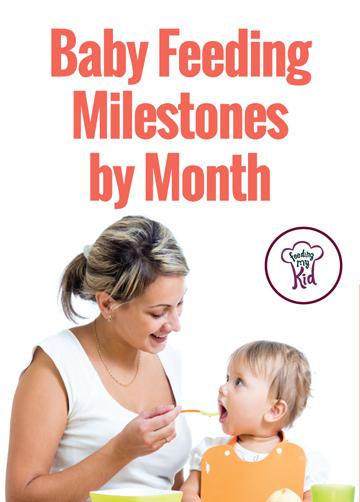 This Article Covers Feeding Milestones from 4-12 Months
This Article Covers Feeding Milestones from 4-12 Months
Picky eating is so incredibly common in the US. What if it didn’t have to be? What if you could reduce your child’s chances of becoming a picky eater? Would you try?
The Internet is full of information and misinformation too. I’ve seen popular blogs on Pinterest that say don’t give your baby yogurt or eggs until after a year old.
Due to new research and studies, the new recommendations are for you offer your baby yogurt, eggs, peanut butter, nuts, etc. If you have a family history of allergies, speak to your Doctor first and also read this allergy article too.
Concerned about food allergies? Check out our complimentary article: Is My Baby At Risk for Food Allergies?
Also, bookmark our Ultimate Guide to Introducing Solids to Your Baby covering everything I wish someone told me when I was just starting to feed my twins. This article covers why you shouldn’t become a short-order cook for your child, how to reduce picky eating, how to introduce foods, why posture is important to eating, etc. It has almost everything in one article.
Check out these articles:
- How much should my toddler be eating?
- What to expect 12-18 months?
- Six Feeding Tips For Parents with Infants Turning Six Months
Keep Breastfeeding or Offering Formula
While introducing solid foods to your child, continue breastfeeding or formula feeding. Do not transition your child to cow’s milk or another milk until after 12 months or until your doctor recommends it. Always check with your Pediatrician before making any ch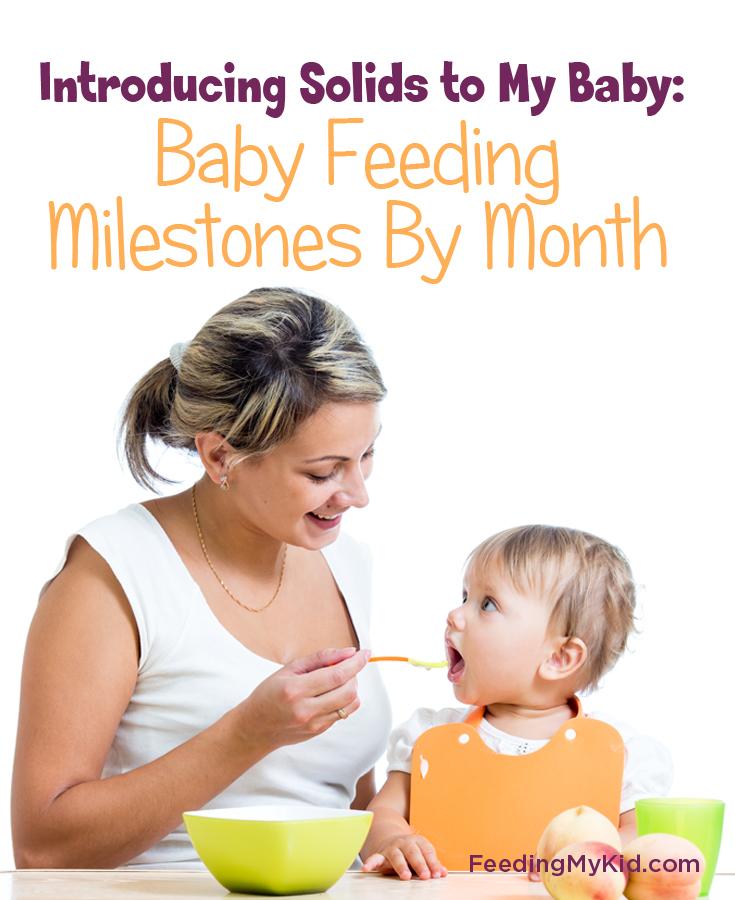 anges to your baby’s diet.
anges to your baby’s diet.
 Not Sure How To Make Your Own Baby Food?
Not Sure How To Make Your Own Baby Food?
We have created a Baby Food Making Guide, which will walk you through all the steps necessary to start making delicious baby food for your little one. Plus, check out all the puree recipes created by parents just like you.
This Article Covers Feeding Milestones from 4-12 Months
Picky eating is so incredibly common in the US. What if it didn’t have to be? What if you could reduce your child’s chances of becoming a picky eater? Would you try?
4 Month Old Feeding Milestones:
Start Introducing Tastes to Your Baby at 4 Months
New research shows that babies are most receptive and accepting of new flavors between 4-7 months of age. Before your child become a fussy eater, teach him to taste.
 “From four to seven months, it seems that there is a window when humans are extraordinarily receptive to flavor, but by following current guidelines on exclusive breastfeeding, parents tend to miss it. Several studies have shown that when vegetables are introduced at this age, babies are more open-minded,” according to author Bee Wilson from her book, First Bite.
“From four to seven months, it seems that there is a window when humans are extraordinarily receptive to flavor, but by following current guidelines on exclusive breastfeeding, parents tend to miss it. Several studies have shown that when vegetables are introduced at this age, babies are more open-minded,” according to author Bee Wilson from her book, First Bite.
Despite what the WHO says about introducing foods after 6 months, introducing foods before has positive effects that will play out for the rest of your little one’s life, from childhood to adulthood (2). It can determine whether you have a picky eater, their eating habits and in the long-run, it can determine their identity.
As Bee Wilson said about the World Health Organizations decision:
“…It’s not that a child necessarily needs any nutrition besides milk before 6 months, it’s that you’re missing an opportunity to introduce them to all of these flavors which they would likely accept at this age” (2).
Give Your Baby Small Tastes of Food, Not Meals at This Age
You can start introducing tastes to your baby as young as 4 months – not meals. This just means dip your finger in whatever you have prepared for the family and let your baby taste the food. You can also start by thinning out the baby food with breast milk or your formula. This way they are being introduced to the foods in a way that they recognize. Offer multiple tastes per meal.
The amount you feed your baby while breastfeeding should stay the same, even though you are introducing new foods to them. Start introducing vegetables, fruits, some meats and beans. Try to give them a lot of variety!
Wilson continues in her book to say, “the flavor window is only fully open for a short time, and it seems to begin closing even at the age of 4-6 months. A 2014 study found that when babies were introduced to a single vegetable at six months, pea-puree, they ate significantly less of it than babies who were introduced to a range of purees at four months.”
When you decide to introduce these foods to babies, please make sure that you continue breastfeeding. You’re just giving them a taste.
6 Months Old Feeding Milestones: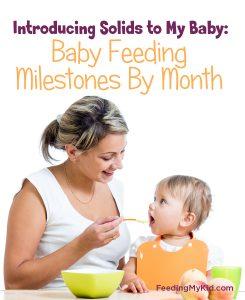
The amount of breast milk or formula should remain the same. You can start introducing fruits, vegetables, rice cereals, dairy (yogurt, cottage cheese, cheese, etc), eggs, meat, fish and beans.
That seems like a lot of variety- because it is! The only thing you should avoid is honey and salt. Also, make sure your cheeses are pasteurized. Don’t offer your child raw cheese. It’s important you skip the sugar too! Read more about the new guidelines on sugar.
Baby Cries While Eating
If your baby is crying while eating, please see  your Doctor.
your Doctor.
Sometimes children could be uncomfortable and that is causing him or her not to eat. I learned about this from a Pediatric Gastroenterologist when we were learning about my son’s allergy. A child can try a food a few times and find it uncomfortable and then not want to do it again.
A child can try a food a few times and find it uncomfortable and then not want to do it again.
It is important to rule out a medical reason for your child’s eating issue. Check out our article about feeding issues to learn more. The article walks through the differences of chocking, gagging, tongue thrusts, and other feeding challenges.
Check out our complimentary article about food allergies in children.
Baby-Led Weaning
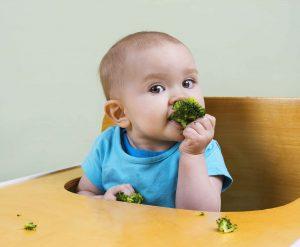 You can also skip the puree phase and do self-feeding (or baby-led weaning) with your child. With baby-led weaning, you can start to give your baby the same types of foods the rest of the family is eating, minus the salt. Learn about the pros and cons in that article.
You can also skip the puree phase and do self-feeding (or baby-led weaning) with your child. With baby-led weaning, you can start to give your baby the same types of foods the rest of the family is eating, minus the salt. Learn about the pros and cons in that article.
I didn’t know about baby-led weaning when I was pregnant with my twins. Now that I do know about, I’m definitely going to do it with baby #3!
Puree Consistency
The consistency of first purees, around 6 months, should be runny as your little one is just getting started. You can add expressed breast milk or formula to your puree to help thin out your baby’s first foods. It’s recommended to add formula or breast milk to thin out the consistency since your baby is already used to this flavor and it can help your baby accept the new foods being offered more readily.
You can start by thinning out the baby food with breast milk or formula. Over the course of the next few weeks, start to thin out the puree less and less until you have a thicker consistency.
To thin out your baby food: You can also add more watery fruits and vegetables to your purees like a pear, apple, cucumber,or zucchini to add liquid to the puree combo to thin it out.
To thicken your baby food: Beans, potatoes, and butternut squash are a great thickening agent if your puree is too runny. You can also add some rice cereal to thicken it up.
Use the water that is left over from steaming or boiling your baby’s food, as the nutrients that leach out of the food will be in the water.
Go at your baby’s pace. It is important to go from runny puree to thicker puree to mashed food with a lot of texture. Learn more about the importance of adding texture to your baby’s food and when you should transition to each stage. It’s well before the months on the baby food bottles!
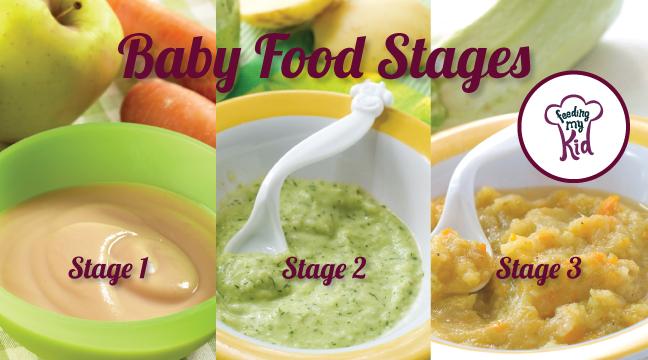
What if my child’s tongue pushes all the food out, gags or throws up?
My kid makes a funny face; does he hate what I’m serving?
7 Month Old Milestones:
You can start introducing a sippy cup filled with breastmilk and/or formula. You can also add a little water into the sippy cup so your child can start getting used to a sippy cup during mealtimes.
Most foods have multiple textures to the food. It’s important you understand how texture works for your baby. If you give your baby a peach (not pureed), it has two very different textures- from the inside of the peach to its fussy skin.
 Some children have a harder time with mixed textures. Other children, mine included, had a hard time with the sliminess of most fruits and vegetables. I ended up having to introduce dehydrated fruits and veggies until my twins overcome their texture aversions.
Some children have a harder time with mixed textures. Other children, mine included, had a hard time with the sliminess of most fruits and vegetables. I ended up having to introduce dehydrated fruits and veggies until my twins overcome their texture aversions.
I also noticed if I gave my kids a whole banana they eagerly ate it, but when I sliced up the banana they would never touch it. It was the same for strawberries. Play with different textures and change up the preparation to find what works for your child.
Once you find something that works, start offering other preparations to introduce your child to a variety of preparations and flavors.
Build on your successes. I speak more to this in my video snacks on the go.
Find out why it’s important you don’t clean up your baby until the end of the meal. You want your baby to be messy! It helps them learn about food.
8 Months Old Milestones:
 Same as above and you can start to introduce more and more textures to your child. You can actually start giving your baby the same foods you are feeding the rest of the family, cut up into sizes your baby can easily handle. Your baby should be having 2-3 solid food meals a day with their breastmilk and/or formula feedings.
Same as above and you can start to introduce more and more textures to your child. You can actually start giving your baby the same foods you are feeding the rest of the family, cut up into sizes your baby can easily handle. Your baby should be having 2-3 solid food meals a day with their breastmilk and/or formula feedings.
Start introducing more solid foods and less purees. Check out our vegetable finger, fruit finger ideas and our mega list of finger food recipes.
Your baby does not need teeth to chew, as long as the food is very soft. A baby’s jaw should be strong enough to grind food. That’s why it’s important to start transitioning off purees, you want your baby to get more practice grinding their food and chewing it. Many people are too afraid of their child choking and may stay on purees too long.
You can start introducing herbs and spices to your child at this age too.
9 Months Old Milestones:
Around this age, babies start to develop their “pincer grip”. If you haven’t already, start giving your baby more opportunities to developer his pincer grip. Check out the article what’s normal eating for 9-12 months. It’s an informative article about everything happening from 9-12 months.
Your baby should be enjoying three meals a day at this point. Your baby should also be mastering how to chew foods like ground beef. Consider weaning your baby off purees at this point.
Tip: Try not to let your baby suck on those puree pouches. It is important for babies to learn to put their lips and mouth over spoons. Plus, your baby might not be getting enough practice chewing if they are always sucking on these pouches. Also, children who stay on these pouches for too long can have more picky eating issues later on.
10 Months Old Milestones:
The amount of breast milk or formula your child is drinking is probably starting to decrease as the amount of solid food is increasing. This is completely normal. You can start having him eat meals that the whole family is eating, as long as the food is soft and cut up.
If your child is only eating purees, consider offering him more whole foods at this point. Some kids don’t like being spoon-fed and would prefer to feed themselves. When a child picks up foods that are age appropriate and feeds himself it is called baby-led weaning or self-feeding. Each child is different and go with what works best for you and your child!
You can cut up whole foods in larger chunks for your child to pick up and take bites of the food. Even babies without teeth can grind food with his gums.
Watch this Video on Why To Cup Up Veggies Into the Shape of Fries
11 Month Old Milestones:
Don’t worry if your child doesn’t use utensils. Right now, it’s more important for you to make mealtimes enjoyable for you and your baby! You can offer your child a spoon or a fork, but it’s probably more for fun than anything else. Don’t worry, your little one won’t eat like a barbarian forever!
If your child is struggling with textures and table food, please reach out to your Pediatrician to get an evaluation with an Occupational Therapist and/or Feeding Specialist.
These specialists can provide you with exercises and tips on how to best help your child overcome your child’s possible feeding challenges. Also, see our article about understanding feeding issues to learn more about the different kinds of feeding issues that can happen.
I couldn’t be a bigger advocate for early feeding intervention. If you are concerned seek a Feeding Specialist for an evaluation.
When Do You Need to See an Occupational Therapist
12+ Months Old Milestones:
Now, your child should be comfortable with eating all types of foods. Your child should be comfortable eating chopped up versions of the foods you are serving your family. If you are making family meals, try to remove your child’s portion of food before you salt the dish.
 It’s important to incorporate flavors, spices and herbs to your young one, but not the salt.
It’s important to incorporate flavors, spices and herbs to your young one, but not the salt.
Speak with your Pediatrician before weaning your child from breastmilk and/or formula. It is important for young toddlers to get 40-50% of their daily calories from fat for brain development. Offer your child full-fat yogurt, cottage cheese, milk, butter, etc.
Unless your Doctor tells you to give lower fat products to your child, aim to offer your child full-fat options and question your Doctor about why he or she would recommend lower fat foods to your child. New research indicates there is a lot of value in having kids drink whole milk. Whole milk is more filling and may reduce the need to snack (5).
Many Pediatricians recommend switching children to low-fat milk (after they’re 2) to decrease fat (1). The reason why you don’t want to give kids under 2 years old low-fat milk is because they need the fat from the milk to help them grow and develop (4). I would caution not to make this switch until after 3 years old because the brain grows from 25% to 90% in the first three years and our brains need a high fat diet to help with brain development. If you’re concerned about your child’s weight, pull back on empty calorie foods like crackers, pretzels, fruit snacks (processed, not whole fruit), etc.
Try to avoid empty calories and provide healthy snack options for your toddler.
Check out this article to learn how much a toddler should be eating.
What’s Next:
Read What to Expect for 12-18 Months
Subscribe to our Youtube Channel for our video series about how to best feed your baby, toddler, and school-aged child.
 Sources:
Sources:
(1) Quenqua, Douglas. “Infants Are Fed Solid Food Too Soon, C.D.C. Finds.”The New York Times. The New York Times, 24 Mar. 2013. Web
(2)”Infant – Food and Feeding.” American Academy of Pediatrics. N.p., n.d. Web
(3) Satter, Ellyn. “Avoid Pressure.” Ellyn Satter Institute. N.p., 2015. Web.
(4) “Parental Influence on Children’s Food Preferences and Energy Intake.” European Food Information Council. N.p., Sept. 2012. Web
The information on this website is designed for educational and/or entertainment purposes only. The information provided is not intended to be a substitute for informed medical advice or care. Please consult a doctor with any questions or concerns regarding your child’s condition. You should not use this information to diagnose or treat any health problems or illnesses.

